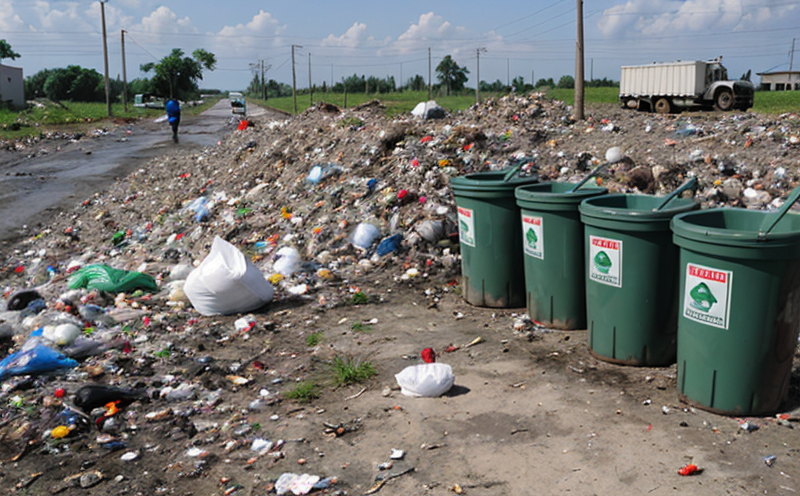ASTM D7363 PFAS in Solid Waste Test
The PFAS family of chemical compounds is a group of synthetic chemicals known for their widespread use across various industries. These compounds are highly stable and persistent, leading to their presence in the environment even after disposal or release into waste streams. The environmental testing sector recognizes the critical need to monitor PFAS levels in solid waste to ensure compliance with regulatory standards and reduce environmental impact.
American Society for Testing and Materials (ASTM) D7363 provides a standardized method for determining the concentration of per- and polyfluoroalkyl substances (PFAS) in solid waste. This service is essential for quality managers, compliance officers, R&D engineers, and procurement teams responsible for ensuring that their products or processes do not inadvertently introduce harmful PFAS into the environment.
The ASTM D7363 test procedure involves several key steps. Initially, a representative sample of the solid waste must be collected using appropriate sampling techniques to ensure accuracy. The chosen method could involve direct collection from landfills, incineration ash, or other relevant sources depending on the nature of the waste being analyzed.
Once the sample is collected, it undergoes rigorous preparation steps which may include digestion in a suitable solvent followed by filtration and concentration processes if necessary. This ensures that all PFAS compounds are adequately extracted from the solid matrix so they can be quantified accurately using chromatographic techniques like liquid chromatography with tandem mass spectrometry (LC-MS/MS).
During this process, strict adherence to quality control measures is paramount. Calibration standards should be prepared according to specified concentrations outlined in ASTM D7363 ensuring consistent results across multiple analyses. Additionally, blanks and spikes must also be run alongside test samples to account for potential contamination issues or matrix effects that might affect the accuracy of measurements.
The instrument used will typically involve high-performance liquid chromatography (HPLC) coupled with mass spectrometry (MS). This combination allows for precise separation and identification of individual PFAS species within complex environmental matrices. The detection limits specified in ASTM D7363 are generally very low, making it possible to detect even trace amounts of these contaminants present in solid waste.
After completing the analysis, comprehensive reports are generated detailing the concentration levels of different PFAS compounds found in each sample analyzed. These reports serve as crucial documentation for regulatory compliance purposes and help inform decision-making regarding waste management practices or product formulations aimed at minimizing environmental harm caused by PFAS contamination.
In summary, the ASTM D7363 PFAS in solid waste test is a vital tool for industries dealing with hazardous waste materials. By providing accurate data on PFAS concentrations present within various types of solid wastes, this service enables stakeholders to make informed decisions about proper disposal methods and potential mitigation strategies aimed at reducing environmental risks associated with PFAS exposure.
Why It Matters
The presence of PFAS in the environment has been linked to numerous health concerns for both humans and wildlife. These chemicals can accumulate in soil, water bodies, and ecosystems over time due to their persistent nature. As a result, monitoring PFAS levels in solid waste is crucial not only from an environmental perspective but also for public safety.
Regulatory agencies around the world have begun implementing stringent regulations governing the disposal of PFAS-containing materials. In the United States, for instance, the Environmental Protection Agency (EPA) has issued a proposed rule under the Toxic Substances Control Act that would require manufacturers and importers to report certain information about PFAS chemicals used in their products.
Compliance with these regulations is essential for businesses operating within this sector. Failure to adhere could lead to legal penalties, reputational damage, and increased operational costs due to necessary remediation efforts. Therefore, investing in reliable testing services like the ASTM D7363 PFAS in solid waste test can help organizations stay ahead of regulatory requirements while demonstrating their commitment to sustainable practices.
Moreover, understanding the levels of PFAS present in solid waste allows companies to implement targeted strategies aimed at reducing emissions or incorporating safer alternatives into their supply chains. By doing so, they contribute positively towards minimizing the overall environmental footprint associated with PFAS usage.
Environmental and Sustainability Contributions
- Pollution Prevention: By identifying and quantifying PFAS in solid waste through ASTM D7363 testing, organizations can take proactive measures to prevent further contamination of natural resources. This helps protect soil, water sources, and biodiversity from long-term harm.
- Resource Efficiency: Proper management of PFAS-contaminated materials allows for more efficient use of landfill space or alternative disposal methods that minimize waste generation while adhering to environmental standards.
- Economic Benefits: Early detection of PFAS contamination enables businesses to address issues promptly, avoiding costly cleanups and potential fines. Additionally, sustainable practices can lead to long-term cost savings by reducing resource consumption and improving operational efficiency.
Use Cases and Application Examples
| Application Example | Description |
|---|---|
| Landfill Leachate Monitoring | Landfills often generate leachate containing various pollutants, including PFAS. Regular testing using ASTM D7363 ensures that landfill operators are aware of any potential contamination issues early enough to take corrective actions. |
| Incineration Ash Analysis | In some cases, incinerated waste produces ash containing trace amounts of PFAS. Testing this ash helps determine if additional treatment steps are required before disposal or recycling. |
| Composting Facilities | Organic composting facilities may inadvertently introduce PFAS into their products through contaminated raw materials. Routine testing ensures that only clean compost is sold to consumers, promoting safer agricultural practices. |
| Construction Site Waste Streams | Waste generated during construction projects often includes items treated with PFAS-based fire retardants or coatings. Analyzing these waste streams helps identify sources of potential contamination upstream in the supply chain. |
The ASTM D7363 PFAS in solid waste test plays a crucial role across various industries, from municipal waste management to industrial processes involving hazardous materials. Its application extends beyond mere compliance; it serves as an important tool for environmental stewardship and sustainable development.





